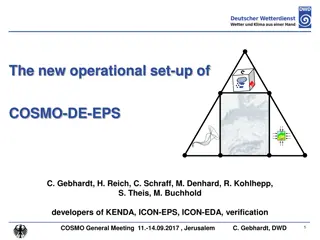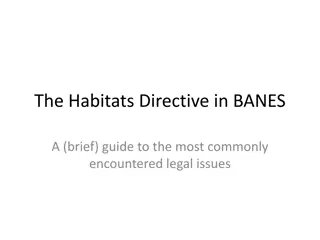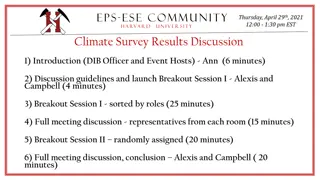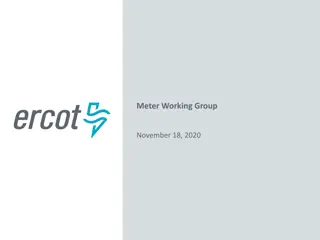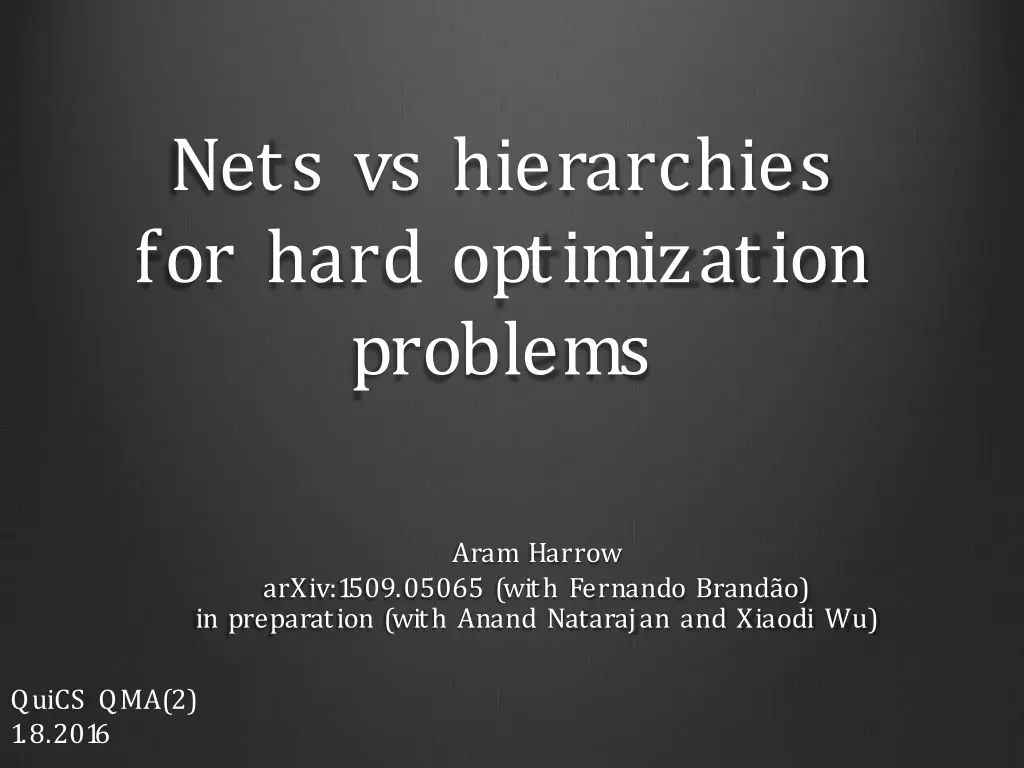
Optimization Problems: Nets vs Hierarchies in Quantum Computing
Explore the comparison between nets and hierarchies for hard optimization problems in quantum computing. Discuss separable states, operator norms, entanglement, optimization definitions, and complexities like Small-Set Expansion and Unique Games. Discover a hierarchy of tests for entanglement in quantum systems.
Download Presentation

Please find below an Image/Link to download the presentation.
The content on the website is provided AS IS for your information and personal use only. It may not be sold, licensed, or shared on other websites without obtaining consent from the author. If you encounter any issues during the download, it is possible that the publisher has removed the file from their server.
You are allowed to download the files provided on this website for personal or commercial use, subject to the condition that they are used lawfully. All files are the property of their respective owners.
The content on the website is provided AS IS for your information and personal use only. It may not be sold, licensed, or shared on other websites without obtaining consent from the author.
E N D
Presentation Transcript
Nets vs hierarchies for hard optimization problems Aram Harrow arXiv:1509.05065 (with Fernando Brand o) in preparation (with Anand Natarajan and Xiaodi Wu) QuiCS QMA(2) 1.8.201 6
outline 1. separable states and operator norms 2. approximating the set of separable states 3. approximating general operator norms 4. the simple case of the simplex
entanglement and optimization Definition: is separable (i.e. not entangled) if it can be written as = i pi |vi vi| |wi wi| Sep = conv{|vi vi| |wi wi|} = conv{ } = probability distribution unit vectors Weak membership problem: Given and the promise that Sep or is far from Sep, determine which is the case. Optimization: hSep(M):= max { tr[M ] : Sep }
operator norms X:A->B ||X||A->B = sup ||Xa||B / ||a||A operator norm Examples largest singular value MAX-CUT = max{ vec(X), a b : ||a|| , ||b|| 1} maxi,j |Xi,j| = max{ vec(X), a b : ||a||1, ||b||1 1} channel distinguishability (cb norm, diamond norm) max output p-norm, min output R nyi-p entropy hypercontractivity, small-set expansion hSep= max{ Choi(X), a b : ||a||S1, ||b||S1 1 } l2 l2 l l1 l1 l S1 -> S1 of X id S1 -> Sp l2 l4 S1 S
complexity of hSep hSep(M) 0.1 ||M||2 2 at least as hard as planted clique [Brubaker, Vempala 09] 3-SAT[log2(n) / polyloglog(n)] [H, Montanaro 10] hSep(M) 100 hSep(M) at least as hard as small-set expansion [Barak, Brand o, H, Kelner, Steurer, Zhou 12] hSep(M) ||M||2 2 / poly(n) at least as hard as 3-SAT[n] [Gurvits 03], [Le Gall, Nakagawa, Nishimura 12]
complexity of l2l4 norm Unique Games (UG): Given a system of linear equations: xi xj = aij mod k. Determine whether 1- or fraction are satisfiable. Small-Set Expansion (SSE): Is the minimum expansion of a set with n vertices 1- or ? UG SSE 2->4 G = normalized adjacency matrix P = largest projector s.t. G P Theorem: All sets of volume have expansion 1 - O(1) iff ||P ||2->4 n-1/4/ O(1)
A hierachy of tests for entanglement Definition: AB is k-extendable if there exists an extension with for each i. all quantum states (= 1-extendable) 2-extendable 100-extendable separable = -extendable Algorithms: Can search/optimize over k-extendable states in time nO(k). Question: How close are k-extendable states to separable states?
SDP hierarchies for hSep Sep(n,m) = conv{ 1 ... m : m Dn} SepSym(n,m) = conv{ m : Dn} bipartite doesn t match hardness Thm: If M = i Ai Biwith i |Bi| I, each |Ai| I, then hSep(n,2)(M) hk-ext(M) hSep(n,2)(M) + c (log(n)/k)1 /2 [Brand o, Christandl, Yard 10], [Yang 06], [Brand o, H 12], [Li, Winter 12] multipartite Thm: -approx to hSepSym(n,m)(M) in time exp(m2 log2(n)/ 2). -approx to hSep(n,m)(M) in time exp(m3 log2(n)/ 2). [Brand o, H 1 2], [Li, Smith 14] matches Chen-Drucker hardness
proof intuition Measure extended state and get outcomes p(a,b1, ,bk). Possible because of 1-LOCC form of M. case 2 p(a,b2 | b1) has less mutual information case 1 p(a,b1) p(a) p(b1)
questions Run-time exp(c log2(n) / 2) appears in both Algorithm for M in 1-LOCC Hardness for M in SEP. Why? Can we bridge the gap? Can we find multiplicative approximations, or otherwise use these approaches for SSE?
net-based algorithms M = i [m] Ai Biwith i Ai I, each |Bi| I, Ai 0 Hierarchies estimate hSep(M) in time exp(log2(n)/ 2) hSep(M) = max , tr[M( )] = maxp S ||p||B Dn Ai p p S pi = tr[Ai ] m [0,1] Bi ipiBi B(S ) S= {p : Dn s.t. pi = tr[Ai ]} m ||x||B= || i xi Bi||2->2
net-based algorithms hSep(M) = max , tr[M( )] = maxp S ||p||B ipiBi B(S ) p S Dn ||x||B= || i xi Bi||2->2 m S= {p : Dn s.t. pi = tr[Ai ]} Lemma: p m q k-sparse (i.e. Zm/k) s.t. ||p-q||B c(log(n)/k)1 /2. Pf: matrix Chernoff [Ahlswede-Winter] Performance k log(n)/ 2, m=poly(n) run-time O(mk) = exp(log2(n)/ 2) Algorithm: Enumerate over k-sparse q check whether p S, ||p-q||B if so, compute ||q||B
nets for Banach spaces X:A->B ||X||A->B = sup ||Xa||B / ||a||A operator norm ||X||A->C->B = min {||Z||A->C ||Y||C->B : X=YZ} factorization norm Let A,B be arbitrary. C = l1m Only changes are sparsification (cannot assume m poly(n)) and operator Chernoff for B. A Type-2 constant: T2(B) is smallest such that C=l1m result: estimated in time exp(T2(B)2log(m)/ 2) B
applications S1 Sp norms of entanglement-breaking channels N( ) = i tr[Ai ]Bi, where i Ai = I, ||Bi||1 = 1. Can estimate ||N||1 p in time nO(c) where c = p/ 2 for p 2 c = (p/ p)1 /(p-1) for 1<p<2 (uses bounds on T2(Sp) from [Ball-Carlen-Lieb 94] low-rank measurements: hSep( i Ai Bi) for i|Ai|=1, ||Bi|| 1, rank Bi r in time nO(r/ 2) l2 lpfor even p 4 in time nO(p/ 2) Multipartite versions of 1-LOCC norm too [cf. Li-Smith 14]
-nets vs. SoS Problem maxp pTAp SoS/info theory DF 80 BK 02, KLP 06 HNW 1 6 -nets BK 02, KLP 06 approx Nash LMM 03 free games AIM 14 BH 13 unique games ABS 10 BRS 11 small-set expansion hSep ABS 10 BBHKSZ 1 2 SW 11 BH 15 BCY 10 BH 12 BKS 13
simplest version: polynomial optimization over the simplex n = {p Rn: p 0, i pi = 1} Given homogenous degree-d poly f(p1, , pn), find maxp f(p). NP-complete: given graph G with clique number , maxp pTAp = 1 1/ . [Motzkin-Strauss, 65] Approximation algorithms Net: Enumerate over all points in n(k) := n Zn/k. Hierarchy: min s.t. ( i pi)k ( ( i pi)d-f(p)) has all nonnegative coefficients. Thm: Each gives error (maxpf(p)-minpf(p)) exp(d) / k in time nO(k). [de Klerk, Laurent, Parrilo, 06]
sum-of-squares (SoS) proofs Axioms: g1(x) 0 gm(x) 0 f(x) derive Rules: 1. polynomial operations 2. intermediate polys have deg k 3. [optional: changes LP to SDP] r(x)2 0 for any polynomial r(x) Positivestellensatz [Stengel 74]
hierarchies & SoS proofs Given axioms: i pi = 1 and pi 0 prove that f(p) 0. Previous strategy: ( i pi)d - f(p)= ( i pi)k ( ( i pi)d - f(p) 0 difference is divisible by 1 - i pi LHS is nonnegative sum of products of pi Dual is equivalent to net enumeration for modified objective function. [Bomze, de Klerk 02] [de Klerk, Laurent, Sun 14]
k-extendable hierarchy For a deg-d homogenous poly f(p), define vec(f) (Rn) d to be the symmetric tensor such that f(x) = vec(f), x d . Then maxp f(p) = hK(vec(f)) for K = conv{p d : p n} hK(y) := maxx K x,y relaxation: q nd+ksymmetric (aka exchangeable ) = q(1,2,..,d) convergence: [Diaconis, Freedman 80] dist( , conv{p d}) O(d2/k) error ||vec(f)|| / k in time nO(k)
Nash equilibria Non-cooperative games: Players choose strategies pA m, pB n. Receive values VA, pA pB and VB, pA pB . Nash equilibrium: neither player can improve own value -approximate Nash: cannot improve value by > Correlated equilibria: Players follow joint strategy pAB mn. Receive values VA, pAB and VB, pAB . Cannot improve value by unilateral change. Can find in poly(m,n) time with LP. Nash equilibrium = correlated equilibrum with p = pA pB
finding (approximate) Nash eq Known complexity: Finding exact Nash eq. is PPAD complete. Optimizing over exact Nash eq is NP-complete. Algorithm for -approx Nash in time exp(log(m)log(n)/ 2) based on enumerating over nets for m, n. Planted clique and 3-SAT[log2(n)] reduce to optimizing over -approx Nash. [Lipton, Markakis, Mehta 03], [Hazan-Krauthgamer 11], [Braverman, Ko, Weinstein 14] New result [HNW16]: Another algorithm for finding -approximate Nash with the same run-time. (uses k-extendable distributions)
algorithm for approx Nash Search over such that the A:Bi marginal is a correlated equilibrium conditioned on any values for B1, , Bi-1. LP, so runs in time poly(mnk) Claim: Most conditional distributions are product. Proof: log(m) H(A) I(A:B1...Bk) = 1 i k I(A:Bi|B<i) ?i I(A:Bi|B<i) log(m)/k =: 2 k = log(m)/ 2 suffices.
open questions Application to unique games, small-set expansion, etc. Which norms are the right ones here? Tight hardness results, e.g. for hSep. Explain the coincidences!








